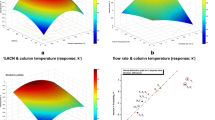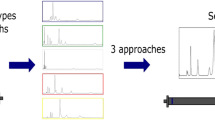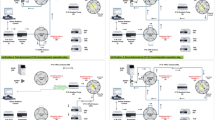Abstract
This paper presents a chemometrics-assisted optimization study to improve the separation of tocopherol (-T) and tocotrienol (-TT) homologues on a C30 stationary phase in reversed-phase HPLC. The HPLC settings were optimized using a central composite design and the response surface methodology. Flow rate, column temperature, and mobile phase composition were chosen as independent variables. Peak resolution (Rs), analysis time (tR), and peak symmetries of the tocopherol isomers were chosen as response variables. Optimum performance in terms of Rs was obtained at a flow rate of 0.31 mL min−1, a temperature of 8.70 °C, and % B content (methyl tert-butyl ether: methanol: water, 80:18:2, v/v/v) in the mobile phase of 38.12%. The analysis of variance and regression analysis gave adjusted R2 values of 0.9841 for Rs, 0.9850 for tR-(α-T), 0.9853 for tR-(β-T), and 0.9204 for the peak symmetry of β-T. This confirms the good agreement of experimental data with predicted values. The close eluting peaks of β-/γ-tocol could be baseline separated at the optimized conditions at a minimized analysis time. Empirical second-order polynomial models were derived that gave statistically high significances (P < 0.0001). Hence, the models can be successfully employed to predict the optimum separation conditions of co-eluting peaks of β-/γ-tocols. The optimized method was successfully applied to determine the individual tocol homologues in various cold pressed edible oils. Total contents ranged from 15 to almost 2600 mg tocol kg−1 oil.




Similar content being viewed by others
References
Lampi AM, Nurmi T, Piironen V (2010) Effects of the environment and genotype on tocopherols and tocotrienols in wheat in the HEALTHGRAIN diversity screen. J Agric Food Chem 58:9306–9313
Wang X, Song YE, Li JY (2013) High expression of tocochromanol biosynthesis genes increases the vitamin e level in a new line of giant embryo rice. J Agric Food Chem 61:5860–5869
Franke AA, Murphy SP, Lacey R, Custer LJ (2007) Tocopherol and tocotrienol levels of foods consumed in Hawaii. J Agric Food Chem 55:769–778
Cunha SC, Amaral JS, Fernandes JO, Oliveira MBP (2006) Quantification of tocopherols and tocotrienols in portuguese olive oils using HPLC with three different detection systems. J Agric Food Chem 54:3351–3356
Aggarwal BB, Sundaram C, Prasad S, Kannappan R (2010) Tocotrienols, the vitamin E of the 21st century: its potential against cancer and other chronic diseases. Biochem Pharmacol 80:1613–1631
Hunter SC, Cahoon EB (2007) Enhancing vitamin E in oilseeds: unraveling tocopherol and tocotrienol biosynthesis. Lipids 42:97–108
Ng LT, Huang SH, Chen YT, Su CH (2013) Changes of tocopherols, tocotrienols, γ-oryzanol, and γ-aminobutyric acid levels in the germinated brown rice of pigmented and nonpigmented cultivars. J Agric Food Chem 61:12604–12611
Inoue T, Tatemori S, Muranaka N et al (2012) The identification of vitamin E homologues in medicinal plant samples using ESI(+)–LC–MS3. J Agric Food Chem 60:9581–9588
Saini RK, Keum Y-S (2016) Tocopherols and tocotrienols in plants and their products: a review on methods of extraction, chromatographic separation, and detection. Food Res Int 82:59–70
Jiang Q (2014) Natural forms of vitamin E: Metabolism, antioxidant, and anti-inflammatory activities and their role in disease prevention and therapy. Free Radic Biol Med 72:76–90
Strohschein S, Pursch M, Lubda D, Albert K (1998) Shape selectivity of C30 phases for RP-HPLC separation of tocopherol isomers and correlation with MAS NMR data from suspended stationary phases. Anal Chem 70:13–18
Gentili A, Caretti F, Bellante S et al (2013) Comprehensive profiling of carotenoids and fat-soluble vitamins in milk from different animal species by LC–DAD–MS/MS hyphenation. J Agric Food Chem 61:1628–1639
Irakli MN, Samanidou VF, Papadoyannis IN (2012) Optimization and validation of the reversed-phase high-performance liquid chromatography with fluorescence detection method for the separation of tocopherol and tocotrienol isomers in cereals, employing a novel sorbent material. J Agric Food Chem 60:2076–2082
Tsochatzis ED, Tzimou-Tsitouridou R (2015) Validated RP-HPLC method for simultaneous determination of tocopherols and tocotrienols in whole grain barley using matrix solid-phase dispersion. Food Anal Methods 8:392–400
Panfılı G, Fratıannı A, Irano M (2003) Normal phase high-performance liquid chromatography method for the determination of tocopherols and tocotrienols in cereals. J Agric Food Chem 51:3940–3944
Kamal-Eldin A, Görgen S, Pettersson J, Lampi A-M (2000) Normal-phase high-performance liquid chromatography of tocopherols and tocotrienols. J Chromatogr A 881:217–227
Gruszka J, Kruk J (2007) RP-LC for determination of plastochromanol, tocotrienols and tocopherols in plant oils. Chromatographia 66:909–9013
Franke AA, Morrison CM, Custer LJ et al (2013) Simultaneous analysis of circulating 25-hydroxy-vitamin D3, 25-hydroxy-vitamin D2, retinol, tocopherols, carotenoids, and oxidized and reduced coenzyme Q10 by high performance liquid chromatography with photo diode-array detection using C18 and C30 column. J Chromatogr A 1301:1–9
Emenhiser C, Sander LC, Schwartz SJ (1995) Capability of a polymeric C30 stationary phase to resolve cis-trans carotenoid isomers in reversed-phase liquid chromatography. J Chromatogr A 707:205–216
Gundersen TE, Blomhoff R (2001) Qualitative and quantitative liquid chromatographic determination of natural retinoids in biological samples. J Chromatogr A 935:13–43
Shammugasamy B, Ramakrishnan Y, Manan F, Muhammad K (2015) Rapid reversed-phase chromatographic method for determination of eight vitamin E isomers and γ-oryzanols in rice bran and rice bran oil. Food Anal Methods 8:649–655
Henry CW, Fortier CA, Warner IM (2001) Separation of tocopherol isomers using capillary electrochromatography: comparison of monomeric and polymeric C30 stationary phases. Anal Chem 73:6077–6082
Duan Q, Liu C, Liu Z et al (2014) Preparation and evaluation of a novel monolithic column containing double octadecyl chains for reverse-phase micro high performance liquid chromatography. J Chromatogr A 1345:174–181
Lerma MJ, Herrero-Martínez JM, Simó-Alfonso EF, Ramis-Ramos G (2007) Determination of tocopherols in vegetable oils by CEC using methacrylate ester-based monolithic columns. Electrophoresis 28:4128–4135
Abidi SL and MTL (1997) Reversed-phase high-performance liquid chromatographic separations of tocopherols. J Chromatogr 782:25–32
Grebenstein N, Frank J (2012) Rapid baseline-separation of all eight tocopherols and tocotrienols by reversed-phase liquid-chromatography with a solid-core pentafluorophenyl column and their sensitive quantification in plasma and liver. J Chromatogr A 1243:39–46
Stöggl W, Huck C, Wongyai S et al (2005) Simultaneous determination of carotenoids, tocopherols, and γ-oryzanol in crude rice bran oil by liquid chromatography coupled to diode array and mass spectrometric detection employing silica C30 stationary phases. J Sep Sci 28:1712–1718
Sen S, Mondal U, Singh G (2016) Dual optimization in phase transfer catalyzed synthesis of dibenzyl sulfide using response surface methodology. Org Process Res Dev 20:1765–1773
Islam MA, Sakkas V, Albanis TA (2009) Application of statistical design of experiment with desirability function for the removal of organophosphorus pesticide from aqueous solution by low-cost material. J Hazard Mater 170:230–238
Arslan FN, Kara H (2016) Fully automated three-dimensional column-switching SPE–FIA–HPLC system for the characterization of lipids by a single injection: part I. Instrumental design and chemometric approach to assess the effect of experimental settings on the response of ELSD. J Am Oil Chem Soc 93:11–26
Sujoy Bose C, Das (2014) Role of binder and preparation pressure in tubular ceramic membrane processing: design and optimization study using response surface methodology (RSM) role of binder and preparation pressure in tubular ceramic membrane processing : design and optimization. Ind Eng Chem Res 53:12319–12329
Arslan FN, Kara H (2017) Central composite design and response surface methodology for the optimization of—Ag+—HPLC/ELSD method for triglyceride profiling. J Food Meas Charact 11:902–912
Knecht K, Sandfuchs K, Kulling SE, Bunzel D (2015) Tocopherol and tocotrienol analysis in raw and cooked vegetables: a validated method with emphasis on sample preparation. Food Chem 169:20–27
Brereton RG (1997) Multilevel multifactor designs for multivariate calibration. Analyst 122:1521–1529
Kamal-eldin A, Andersson R (1997) A multivariate study of the correlation between tocopherol content and fatty acid composition in vegetable oils. J Am Oil Chem Soc 74:375–380
Bezerra MA, Santelli RE, Oliveira EP et al (2008) Response surface methodology (RSM) as a tool for optimization in analytical chemistry. Talanta 76:965–977
Vildozo D, Ferronato C, Sleiman M, Chovelon JM (2010) Photocatalytic treatment of indoor air: optimization of 2-propanol removal using a response surface methodology (RSM). Appl Catal B Environ 94:303–310
Lundstedt T, Seifert E, Abramo L et al (1998) Experimental design and optimization. Chemom Intell Lab Syst 42:3–40
Li X, Xu X, Albano DR, You T (2011) Optimization using central composite design for antihistamines separation by nonaqueous capillary electrophoresis with electrochemical and electrochemiluminescence detections. Analyst 136:5294
Gritti F, Guiochon G (2013) The van Deemter equation: assumptions, limits, and adjustment to modern high performance liquid chromatography. J Chromatogr A 1302:1–13
Codex Alimentarius Commission (2001) Joint FAO/WHO Food Standards Programme Codex Committee on food additives and contaminants. Food and Agriculture Organization of the United Nations, World Health Organization, London
Acknowledgements
This article is supported financially by the Scientific Research Project Center of Karamanoglu Mehmetbey University (Project number 18-M-17). The authors would also like to thank the Scientific and Technological Research Council of Turkey (TUBITAK) under the 2219 Research Fellowship Program for International Postdoctoral stays for providing the financial scholarship support to carry out this research work.
Author information
Authors and Affiliations
Corresponding author
Ethics declarations
Conflict of interest
One author, Hans-Gerd Janssen, is employed by Unilever, a major user of edible oils and edible oil ingredients. No other conflicts of interest are declared.
Electronic supplementary material
Below is the link to the electronic supplementary material.
Rights and permissions
About this article
Cite this article
Arslan, F.N., Janssen, HG. Chemometrics-Assisted Optimization of Beta-/Gamma-Tocol Separation on a C30 Stationary Phase in Reversed-Phase LC. Chromatographia 81, 1453–1465 (2018). https://doi.org/10.1007/s10337-018-3624-z
Received:
Revised:
Accepted:
Published:
Issue Date:
DOI: https://doi.org/10.1007/s10337-018-3624-z




